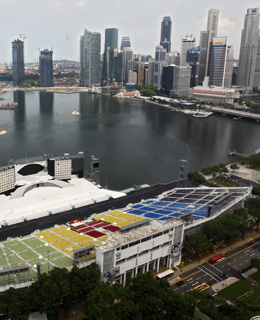
General view of the hotel towers of the Marina Bay Sands Integrated Casino Resort (Left) and the financial district skyline (Right) in Singapore, 08 July 2009.
The condition of Singapore's economy can often be judged from the emerald waters surrounding it. A tiny 268-sq.-mi. (697 sq km) island city-state with the busiest port in the world, Singapore began in 1819 in founder Stamford Raffles' words as an "emporium of goods" and has never forgotten the importance of maritime trade. Today the value of Singapore's annual exports is 2.5 times larger than its entire GDP when all goods passing through the port are counted.
So when idle container vessels, their hulls so empty they bobbed atop the sea like bath toys, began to gather in the Singapore Strait in late 2008, local leaders feared the worst: that a synchronized collapse in global trade would crush the tiny trade-dependent island. The government's economic forecasts were revised downward three times in less than six months. By mid-April the Ministry of Trade and Industry was predicting a record-breaking contraction of up to 9% for 2009. By that point Singapore's benchmark Straits Times stock index had plummeted 60% below its 2007 peak. Property prices tanked 25%. The situation appeared worrying enough for the government to create a 25-member Economic Strategies Committee to assess the basic soundness of Singapore's economic model.
Almost five months later, such alarm appears overdone. GDP in the second quarter soared 20.7% compared with figures for the first three months of 2009. Citigroup economist Kit Wei Zheng now expects at worst a 2.7% contraction for Singapore for 2009. "If you look at the headline economic numbers, like the fall in exports or GDP, this recession seemed severe," says Kit. "But closer to the ground [it has] been quite mild." Singapore's stock market is up more than 70% from its April lows.
The vigor and speed of Singapore's rebound underscore two important facts about its economy. Like others in Asia, Singapore is turning increasingly to trade with China and India to fill the hole left by the collapse in demand from Western consumers. And Singapore, perhaps more adroitly than other Asian countries, is promoting domestic consumption by its cash-rich citizens to help balance an economy that had become dangerously reliant upon external demand for growth.
Not that the city-state is turning its back on globalization — it has just shifted its gaze. China is now Singapore's third largest trading partner after Malaysia and the E.U. More important, an increasing chunk of Singapore's exports to the mainland are directly linked to Chinese domestic consumption instead of to components that are merely re-exported to the West. Citigroup estimates that exports directly linked to Chinese domestic demand account for around 3.9% of Singapore's GDP. "What a crisis like this forces you to do is to broaden your base," says Gautam Banerjee, executive chairman of PricewaterhouseCoopers in Singapore and one of the members of the government's Economic Strategies Committee. "We've stepped up our engagement with China and that will continue."
Singapore has been cozying up to India as well. Bilateral trade between India and Singapore in 2008 amounted to $19.2 billion, a fifth more than the previous year's amount. More astonishingly, that same year Singapore was the second largest foreign direct investor in India, pouring in $3.76 billion. At the same time, Singapore has become a magnet for a new breed of entrepreneurial Indian company, thousands of which are now being welcomed to the city's shores.